Popular categories
Looking for a yarn?

100% Wool
from 2.00 £ /50g
Order DROPS Needles & Hooks
Clicking the ORDER button will redirect you to Wool Warehouse Direct Ltd website
The yarn cost is calculated from the pattern’s smallest size and the yarn’s cheapest product type. Looking for an even better price? You might find it on the DROPS Deals!
Shark Attack Blanket
Crocheted shark blanket for kids. Size 3-14 years Piece is crochet in DROPS Snow.
DROPS design: Pattern ee-138-bn
Yarn group E
----------------------------------------------------------
Size: 3/4 - 5/6 - 7/8 - 9/10 - 11/12 - 13/14 years
Size in cm: 98/104 - 110/116 - 122/128 - 134/140 - 146/152 - 158/164.
Measurements: Length without tail fin = 70-84-98-112-128-142 cm.
Width at the top = 81-86-90-99-103-112 cm.
Circumference before tail = 35-37-39-40-42-44 cm
Tail height = 27-31-33-35-37-39 cm.
Materials:
DROPS SNOW from Garnstudio (belongs to yarn group E)
400-500-600-800-900-950 g colour 46, medium grey
200-200-250-250-300-350 g colour 14, dark grey
50-50-50-50-50-100 g colour 02, black
50 g for all sizes in colour 01, off white
50 g for all sizes in colour 56, Christmas red
Piece can also be crocheted with yarn from:
“Alternative yarn (yarn group E)” - see link below.
DROPS CROCHET HOOK SIZE 8 mm - or size needed to get 9 treble crochets x 5 rows with treble crochets = 10 cm in width and 10 cm vertically.
----------------------------------------------------------
-------------------------------------------------------
Alternative Yarn – See how to change yarns here
Yarn Groups A to F – Use the same pattern and change the yarn here
Yarn usage using an alternative yarn – Use our yarn converter here
-------------------------------------------------------

100% Wool
from 2.00 £ /50g
Order DROPS Needles & Hooks
Clicking the ORDER button will redirect you to Wool Warehouse Direct Ltd website
The yarn cost is calculated from the pattern’s smallest size and the yarn’s cheapest product type. Looking for an even better price? You might find it on the DROPS Deals!
- English (UK/cm)
- Česky
- Dansk
- Deutsch
- Eesti keel
- English (US/in)
- Español
- Français
- Íslenska
- Italiano
- Magyar
- Nederlands
- Norsk
- Polski
- Português
- Suomi
- Svenska
- English (UK/cm), Bulgaria
- English (UK/cm), Croatia
- English (UK/cm), Greece
- English (UK/cm), Latvia
- English (UK/cm), Lithuania
- English (UK/cm), Romania
- English (UK/cm), Slovenia
- Česky, Slovakia
Pattern instructions
INCREASE TIP:
Increase 1 treble crochet by working 2 treble crochets in same stitch.
CROCHET INFO:
The first double crochet on each row is replaced by 1 chain stitch.
The first treble crochet on each row is replaced by 3 chain stitches.
----------------------------------------------------------
BLANKET:
Body of shark is worked bottom up, it begins between body and tail fin. Then work tail fin from bottom of body and downward. The entire piece is worked back and forth.
BODY:
Work 32-34-34-36-38-40 chain stitches on hook size 8 mm with medium grey. Form a ring by working 1 slip stitch in first chain stitch. Then work back and forth. READ CROCHET INFO and work 1 treble crochet in each stitch the entire row = 32-34-34-36-38-40 treble crochets. Turn piece and work 1 treble crochet in every treble crochet the entire row.
On next row increase stitches evenly on row - READ INCREASE TIP! Work treble crochets and increase 8-6-6-9-7-10 treble crochets on row = 40-40-40-45-45-50 treble crochets. REMEMBER THE CROCHET TENSION!
Continue in rows like this, increase along the way - READ ENTIRE SECTION BEFORE CONTINUING!
Increase 5 treble crochets every 4-5-6-8-7-10 cm 6-6-8-7-9-10 times in total = 70-70-80-80-90-100 treble crochets. When all increases are done work 1 row without increase, on next row work treble crochets and increase 3-7-1-9-3-1 treble crochets evenly = 73-77-81-89-93-101 treble crochets. Continue working 1 treble crochet in each treble crochet until piece measures 66-80-94-108-124-138 cm.
Switch to black and work 1 row with 1 double crochet in every treble crochet. Switch red and work 1 row with 1 treble crochet in every double crochet, then work 1 row with 1 double crochet in each treble crochet.
Switch to off white and work next row as follows: 1 chain stitch,* skip 2 double crochet, in next double crochet work: 1 double treble crochet, 2 treble crochets, 1 double treble crochet, 4 chain stitches and 1 slip stitch, then work 1 slip stitch in next double crochet *, repeat from *-* the entire row. Cut the yarn and fasten. Body is now done.
TAIL FIN:
Place body double with vent in the middle of piece. Use dark grey and crochet hook 8 mm, work 1 row with double crochets through both layer at the bottom along the cast-on edge = 16-17-17-18-19-20 double crochets.
Then work every row as follows: 3 treble crochets in first stitch, work 1 treble crochet in every stitch until the 4 middle stitches, 1 double crochet in each of the next 4 stitches, 1 treble crochet in every stitch until last stitch and work 3 treble crochets in last stitch.
Repeat this row 13-15-16-17-18-19 times in total = piece measures approx. 26-30-32-34-36-38 cm. Switch to 2 strands black, work 1 row with 1 double crochet in every stitch. Cut the yarn and fasten.
EYES:
Work 2 eyes, fasten them with medium grey approx. 10 cm from edge at the top.
Work as follows:
Work 3 chain stitches with black on hook size 8 mm and form a ring with 1 slip stitch in first chain stitch.
ROUND 1: Work 3 chain stitches (replaces 1st treble crochet), work 11 treble crochets around ring and finish with 1 slip stitch in 3rd chain stitch (= 12 treble crochets). Cut the yarn and switch to off white.
ROUND 2: Work 1 chain stitch (replaces 1st double crochet), work 1 double crochet in every treble crochet and finish with 1 slip stitch in 1st chain stitch (= 12 double crochets).
ROUND 3: Work 1 chain stitch (replaces 1st double crochet), 1 double crochet in the same stitch, then work 2 double crochets in every double crochet rest of round and finish with 1 slip stitch in 1st chain stitch(= 24 double crochets). Cut the yarn and switch to medium grey.
ROUND 4: Work 1 chain stitch (replaces 1st double crochet), work 1 double crochet in every double crochet and finish with 1 slip stitch in 1st chain stitch (= 24 double crochets). Cut yarn and fasten.
VENT:
Sew vent together as far up as you want - 20-30 cm up if only feet should be covered or half way up if the vent should cover more.
Enjoy your new blanket.
This pattern has been corrected. Click here to see the correction/s.
New yarn amount:
DROPS SNOW from Garnstudio
400-500-600-800-900-950 g colour 46, medium grey
200-200-250-250-300-350 g colour 14, dark grey
Correction made in ROUND 2-4 under EYES.
What can you do with our patterns? You can share DROPS patterns online, using the pattern original picture, materials, name and number. But you are NOT ALLOWED to reproduce the complete pattern digitally in any way. Yarn stores are welcome to use the DROPS pattern database to promote the sale of our assortment. You can print out our patterns, make as many copies as you’d like. The only thing we ask is that you don't make any changes / additions to the original printed document. And that the patterns according to the DROPS philosophy are given out to the consumers for free. Editorials that wish to publish our patterns in printed books or magazines can contact us for more information. The sale of garments based on DROPS patterns is permitted as long as they are sold as single items or per order. Further commercial use of the patterns is not permitted. It has to be clearly stated that the garment is made based on a design from DROPS DESIGN. The use of clothing labels of which DROPS DESIGN forms part is conditioned by the inclusion of the following text: “A DROPS DESIGN made by …..”. The use of DROPS photos for marketing purposes/sales is only permitted in connection with the use/sale of DROPS products. The photos may not be cut or edited and the logo should be clearly visible.
We reserve the right to withdraw the permission for use of our patterns at any time, notwithstanding the reason.
Each of our patterns has specific tutorial videos to help you.
These step-by-step tutorials might also help you:
Why is the knitting/crochet tension so important?
Knitting tension is what determines the final measurements of your work, and is usually measured per 10 x 10 cm. It is provided like so: number of stitches in width x number of rows in height - eg: 19 stitches x 26 rows = 10 x 10 cm.
The knitting tension is very individual; some people knit/crochet loosely while others work tightly. You adjust the knitting tension with the needle size, which is why the suggested needle size is only meant as a guide! You need to adjust this (up or down) to ensure that YOUR knitting tension matches the knitting tension provided in the pattern. If you work with a different knitting tension than provided you will have a different yarn consumption, and your work will have different measurements than what the pattern suggests.
The knitting tension also determines which yarns can replace each other. As long as you achieve the same knitting tension you can replace one yarn with another.
See DROPS lesson: How to measure your tension/gauge
See DROPS video: How to make a gauge tension swatch
How do I know how many balls of yarn I need?
The required amount of yarn is provided in grams, eg: 450 g. To calculate how many balls you’ll need you first need to know how many grams are in 1 ball (25g, 50g or 100g). This information is available if you click on the individual yarn quality on our pages. Divide the amount required with the amount of each ball. For example, if each ball is 50g (the most common amount), the calculation will be as follows: 450 / 50 = 9 balls.
Can I use a different yarn than what the pattern suggests?
The important thing when changing from one yarn to another is that the knitting/crochet tension remains the same. This is so that the measurements of the finished piece will be the same as on the sketch provided. It is easier to achieve the same knitting tension using yarns from the same yarn group. It is also possible to work with multiple strands of a thinner yarn to achieve the knitting tension of a thicker one. Please try our yarn converter. We recommend you to always work a test swatch.
Please NOTE: when changing yarn the garment might have a different look and feel to the garment in the photo, due to individual properties and qualities of each yarn.
See DROPS lesson: Can I use a different yarn than the one mentioned in the pattern?
What are the yarn groups?
All our yarns are categorised into yarn groups (from A to F) according to thickness and knitting tension – group A contains the thinnest yarns and group F the thickest. This makes it easier for you to find alternative yarns to our patterns, should you wish to switch yarn. All yarns within the same group have a similar knitting tension and can easily replace each other. However, different yarn qualities have different structures and properties which will give the finished work a unique look and feel.
How do I use the yarn calculator?
At the top of all our patterns you’ll find a link to our yarn calculator, which is a helpful tool should you wish to use a different yarn than suggested. By filling in the yarn quality you wish to replace, the amount (in your size) and number of strands, the calculator will present good alternative yarns with the same knitting tension. Additionally it will tell you how much you’ll require in the new qualities and whether you’ll need to work with multiple strands. Most skeins are 50g (some are 25g or 100g).
If the pattern is worked with multiple colours, every colour will have to be calculated separately. Similarly, if the pattern is worked with several strands of different yarns (for example 1 strand Alpaca and 1 strand Kid-Silk) you will have to find alternatives for each, individually.
Why do you show discontinued yarns in the patterns?
Since different yarns have different qualities and textures we have chosen to keep the original yarn in our patterns. However, you can easily find options among our available qualities by using our yarn calculator, or simply pick a yarn from the same yarn group.
It is possible that some retailers still have discontinued yarns in stock, or that someone has a few skeins at home that they would like to find patterns for.
The yarn calculator will provide both alternative yarn as well as required amount in the new quality.
What size should I knit?
If you think it's hard to decide what size to make, it can be a good idea to measure a garment you own already and like the size of. Then you can pick the size by comparing those measures with the ones available in the pattern's size chart.
You'll find the size chart at the bottom of the pattern.
See DROPS lesson: How to read size chart
Why do I get the wrong knitting tension with the suggested needle size?
The needle size provided in the pattern serves only as a guide, the important thing is to follow the knitting tension. And since knitting tension is very individual, you will have to adjust the needle size to ensure that YOUR tension is the same as in the pattern – maybe you’ll have to adjust 1, or even 2 needle sizes, up or down to achieve the correct tension. For this, we recommend that you work test swatches.
Should you work with a different knitting tension than the one provided, the measurements of the finished garment might deviate from the measurement sketch.
See DROPS lesson: How to measure your tension/gauge
See DROPS video: How to make a tension/gauge swatch
Why is the pattern worked top-down?
Working a garment top-down provides more flexibility and room for personal adjustment. For example it is easier to try the garment on while working, as well as making adjustments to length of yoke and shoulder caps.
The instructions are carefully explaining every step, in the correct order. Diagrams are adjusted to the knitting direction and are worked as usual.
How do I work according to a knitting diagram?
The diagram depicts all rows/rounds, and every stitch seen from the right side. It is read from bottom to top, from right to left. 1 square = 1 stitch.
When working back and forth, every other row is worked from the right side and every other row is worked from the wrong side. When working from the wrong side, the diagram will have to be worked reversed: from left to right, knit stitches are purled, purl stitches are knit etc.
When working in the round every round is worked from the right side and the diagram are worked from right to left on all rounds.
See DROPS lesson: How to read knitting diagrams
How do I work according to a crochet diagram?
The diagram depicts all rows/rounds, and every stitch seen from the right side. It is worked from bottom to top, from right to left.
When working back and forth every other row is worked from the right side: from right to left and every other row is worked from the wrong side: from left to right.
When working in the round, every row in the diagram are worked from the right side, from right to left.
When working a circular diagram you start in the middle and work your way outwards, counter clockwise, row by row.
The rows usually start with a given number of chain stitches (equivalent to the height of the following stitch), this will either be depicted in the diagram or explained in the pattern.
See DROPS lesson: How to read crochet diagrams
How do I work several diagrams simultaneously on the same row/round?
Instructions for working several diagrams after each other on the same row/round, will often be written like so: “work A.1, A.2, A.3 a total of 0-0-2-3-4 times". This means you work A.1 once, then A.2 is worked once, and A.3 is repeated (in width) the number of times provided for your size – in this case like so: S = 0 times, M = 0 times, L=2 times, XL= 3 times and XXL = 4 times.
The diagrams are worked as usual: begin with the first row in A.1, then work the first row in A.2 etc.
See DROPS lesson: How to read knitting diagrams
See DROPS lesson: How to read crochet diagrams
Why are the sleeves shorter in larger sizes?
The total width of the garment (from wrist-to-wrist) will be larger in the larger sizes, despite the actual sleeves being shorter. The larger sizes have longer sleeve caps and wider shoulders, so there will be a good fit in all sizes.
Where on the garment is the length measured?
The measurement sketch/schematic drawing provides information regarding the full length of the garment. If it’s a jumper or a jacket the length is measured from the highest point on the shoulder closest to the neckline, and straight down to the bottom of the garment. It is NOT measured from the tip of shoulder. Similarly, the length of yoke is measured from the highest point on the shoulder and down to where yoke is split into body and sleeves.
On a jacket measures are never taken along bands, unless specifically stated. Always measure inside band stitches when measuring the length.
See DROPS lesson: How to read a schematic drawing
What is a repeat?
Diagrams are often repeated on the round or in height. 1 repeat is the diagram the way it appears in the pattern. If it says to work 5 repeats of A.1 in the round, then you work A.1 a total of 5 times after/next to each other in the round. If it says to work 2 repeats of A.1 vertically/in height you work the entire diagram once, then begin again at the start and work the entire diagram one more time.
Why does the piece start with more chain stitches than it’s worked with?
Chain stitches are slightly narrower than other stitches and to avoid working the cast-on edge too tight, we simply chain more stitches to begin with. The stitch count will be adjusted on the following row to fit the pattern and measurement sketch.
Why increase before the rib edge when the piece is worked top-down?
The rib edge is more elastic and will contract slightly compared to, for example, stocking stitch. By increasing before the rib edge, you avoid a visible difference in width between the rib edge and the rest of the body.
Why increase in the cast-off edge?
It’s very easy to cast off too tightly, and by making yarn overs while casting off (and simultaneously casting these off) you avoid a too tight cast off edge.
See DROPS video: How to bind off with yarn overs (yo)
How do I increase/decrease on every 3rd and 4th row/round alternately?
To achieve an even increase (or decrease) you can increase on, for example: every 3rd and 4th row alternately, like so: work 2 rows and increase on the 3rd row, work 3 rows and increase on the 4th. Repeat this until the increase is complete.
See DROPS lesson: Increase or decrease 1 st on every 3rd and 4th row alternately
How can I work a jacket in the round instead of back and forth?
Should you prefer to work in the round instead of back and forth, you may of course adjust the pattern. You’ll need to add steeks mid-front (usually 5 stitches), and follow the instructions. When you would normally turn and work from the wrong side, simply work across the steek and continue in the round. At the end you’ll cut the piece open, pick up stitches to work bands, and cover the cut edges.
See DROPS video: How to knit steeks and cut open
Can I work a jumper back and forth instead of in the round?
Should you prefer to work back and forth instead of in the round, you may of course adjust the pattern so you work the pieces separately and then assemble them at the end. Divide the stitches for the body in 2, add 1 edge stitch in each side (for sewing) and work the front and back pieces separately.
See DROPS lesson: Can I adapt a pattern for circular needles into straight needles?
Why is the pattern slightly different than what I see in the photo?
Pattern repeats can vary slightly in the different sizes, in order to get the correct proportions. If you’re not working the exact same size as the garment in the photo, yours might deviate slightly. This has been carefully developed and adjusted so that the complete impression of the garment is the same in all sizes.
Make sure to follow instructions and diagrams for your size!
How do I make a women’s size garment into a men’s size one?
If you have found a pattern you like which is available in women’s size it’s not very difficult to convert it to men’s size. The biggest difference will be the length of sleeves and body. Start working on the women size that you think would fit across the chest. The additional length will be worked right before you cast off for the armhole/sleeve cap. If the pattern is worked top-down you can add the length right after the armhole or before the first decrease on sleeve.
Regarding additional yarn amount, this will depend on how much length you add, but it is better with a skein too many than too few.
How do I prevent a hairy garment from shedding?
All yarns will have excess fibres (from production) that might come off as lint or shedding. Brushed yarns (ie hairier yarns) have more of these loose, excess fibres, causing more shedding.
Shedding also depends on what is worn under or over the garment, and whether this pulls at the yarn fibres. It’s therefore not possible to guarantee that there will be no shedding
Below are some tips on how to get the best result when working with hairier yarns:
1. When the garment is finished (before you wash it) shake it vigorously so the looser hairs come off. NOTE: do NOT use a lint roller, brush or any method that pulls at the yarn.
2. Place the garment in a plastic bag and put it in your freezer - the temperature will cause the fibres to become less attached to each other, and excess fibres will come off easier.
3. Leave in the freezer for a few hours before taking it out and shaking it again.
4. Wash the garment according to the instructions on the yarn label.
Why does my garment pill?
Pilling is a natural process that happens to even the most exclusive of fibers. It's a natural sign of wear and tear that is hard to avoid, and that is most visible in high friction areas of your garment like a sweater's arms and cuffs.
You can make your garment look as new by removing the pilling, using a fabric comb or a pill/lint remover.
In the meantime, you can read the questions and answers that others have left to this pattern or join the DROPS Workshop on Facebook to get help from fellow knitters/crocheters!
You might also like...
Shark Attack Blanket |
|
 |
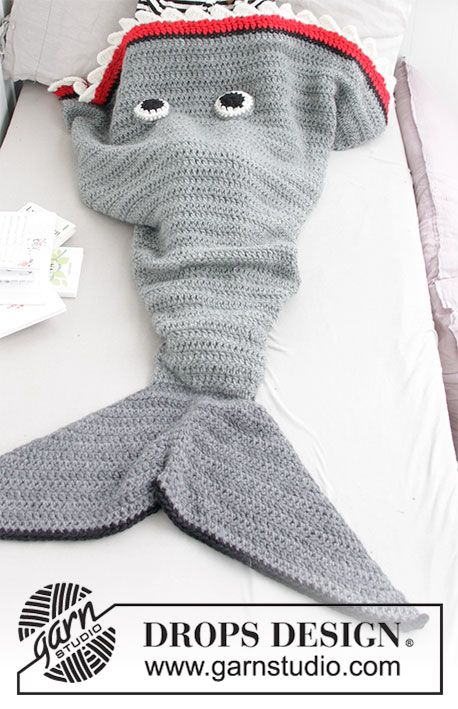 |
Crocheted shark blanket for kids. Size 3-14 years Piece is crochet in DROPS Snow.
DROPS Children 28-13 |
|
|
INFORMATION FOR PATTERN: INCREASE TIP: Increase 1 treble crochet by working 2 treble crochets in same stitch. CROCHET INFO: The first double crochet on each row is replaced by 1 chain stitch. The first treble crochet on each row is replaced by 3 chain stitches. ---------------------------------------------------------- BLANKET: Body of shark is worked bottom up, it begins between body and tail fin. Then work tail fin from bottom of body and downward. The entire piece is worked back and forth. BODY: Work 32-34-34-36-38-40 chain stitches on hook size 8 mm with medium grey. Form a ring by working 1 slip stitch in first chain stitch. Then work back and forth. READ CROCHET INFO and work 1 treble crochet in each stitch the entire row = 32-34-34-36-38-40 treble crochets. Turn piece and work 1 treble crochet in every treble crochet the entire row. On next row increase stitches evenly on row - READ INCREASE TIP! Work treble crochets and increase 8-6-6-9-7-10 treble crochets on row = 40-40-40-45-45-50 treble crochets. REMEMBER THE CROCHET TENSION! Continue in rows like this, increase along the way - READ ENTIRE SECTION BEFORE CONTINUING! Increase 5 treble crochets every 4-5-6-8-7-10 cm 6-6-8-7-9-10 times in total = 70-70-80-80-90-100 treble crochets. When all increases are done work 1 row without increase, on next row work treble crochets and increase 3-7-1-9-3-1 treble crochets evenly = 73-77-81-89-93-101 treble crochets. Continue working 1 treble crochet in each treble crochet until piece measures 66-80-94-108-124-138 cm. Switch to black and work 1 row with 1 double crochet in every treble crochet. Switch red and work 1 row with 1 treble crochet in every double crochet, then work 1 row with 1 double crochet in each treble crochet. Switch to off white and work next row as follows: 1 chain stitch,* skip 2 double crochet, in next double crochet work: 1 double treble crochet, 2 treble crochets, 1 double treble crochet, 4 chain stitches and 1 slip stitch, then work 1 slip stitch in next double crochet *, repeat from *-* the entire row. Cut the yarn and fasten. Body is now done. TAIL FIN: Place body double with vent in the middle of piece. Use dark grey and crochet hook 8 mm, work 1 row with double crochets through both layer at the bottom along the cast-on edge = 16-17-17-18-19-20 double crochets. Then work every row as follows: 3 treble crochets in first stitch, work 1 treble crochet in every stitch until the 4 middle stitches, 1 double crochet in each of the next 4 stitches, 1 treble crochet in every stitch until last stitch and work 3 treble crochets in last stitch. Repeat this row 13-15-16-17-18-19 times in total = piece measures approx. 26-30-32-34-36-38 cm. Switch to 2 strands black, work 1 row with 1 double crochet in every stitch. Cut the yarn and fasten. EYES: Work 2 eyes, fasten them with medium grey approx. 10 cm from edge at the top. Work as follows: Work 3 chain stitches with black on hook size 8 mm and form a ring with 1 slip stitch in first chain stitch. ROUND 1: Work 3 chain stitches (replaces 1st treble crochet), work 11 treble crochets around ring and finish with 1 slip stitch in 3rd chain stitch (= 12 treble crochets). Cut the yarn and switch to off white. ROUND 2: Work 1 chain stitch (replaces 1st double crochet), work 1 double crochet in every treble crochet and finish with 1 slip stitch in 1st chain stitch (= 12 double crochets). ROUND 3: Work 1 chain stitch (replaces 1st double crochet), 1 double crochet in the same stitch, then work 2 double crochets in every double crochet rest of round and finish with 1 slip stitch in 1st chain stitch(= 24 double crochets). Cut the yarn and switch to medium grey. ROUND 4: Work 1 chain stitch (replaces 1st double crochet), work 1 double crochet in every double crochet and finish with 1 slip stitch in 1st chain stitch (= 24 double crochets). Cut yarn and fasten. VENT: Sew vent together as far up as you want - 20-30 cm up if only feet should be covered or half way up if the vent should cover more. Enjoy your new blanket. |
|
|
Have you made this or any other of our designs? Tag your pictures in social media with #dropsdesign so we can see them! Do you need help with this pattern?You'll find tutorial videos, a Comments/Questions area and more by visiting the pattern on garnstudio.com. © 1982-2024 DROPS Design A/S. We reserve all rights. This document, including all its sub-sections, has copyrights. Read more about what you can do with our patterns at the bottom of each pattern on our site. |
|
With over 40 years in knitting and crochet design, DROPS Design offers one of the most extensive collections of free patterns on the internet - translated to 17 languages. As of today we count 304 catalogues and 11422 patterns - 11422 of which are translated into English (UK/cm).
We work hard to bring you the best knitting and crochet have to offer, inspiration and advice as well as great quality yarns at incredible prices! Would you like to use our patterns for other than personal use? You can read what you are allowed to do in the Copyright text at the bottom of all our patterns. Happy crafting!







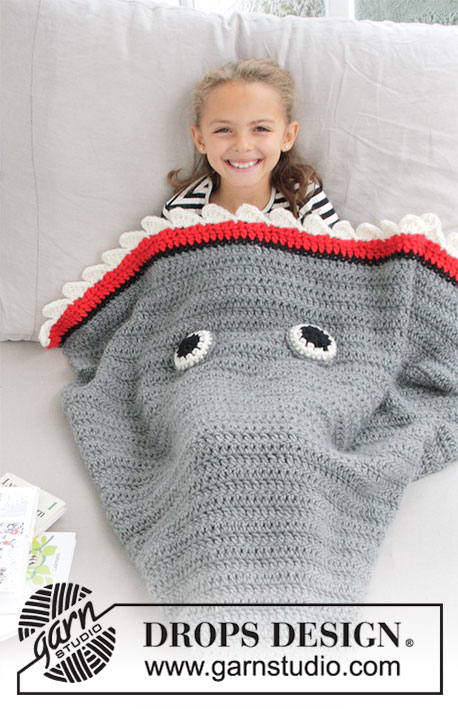
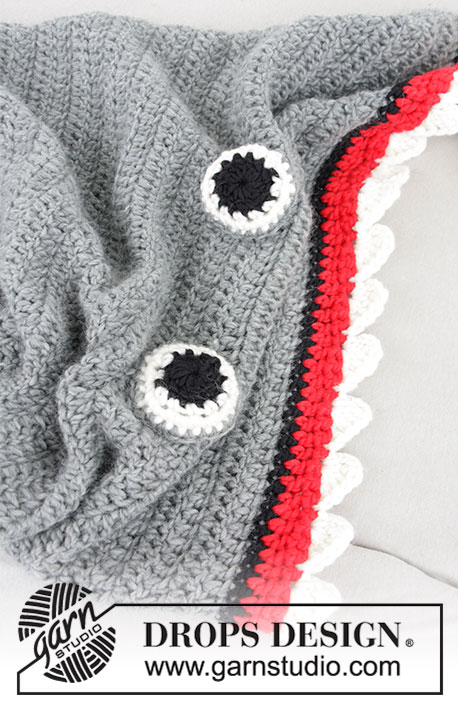



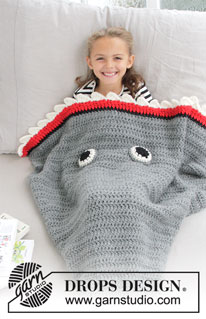
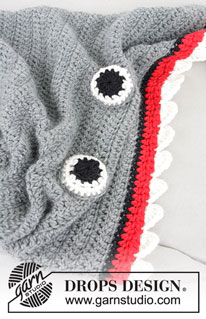
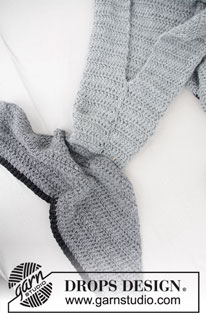





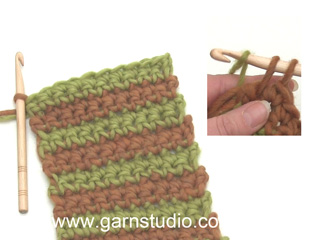
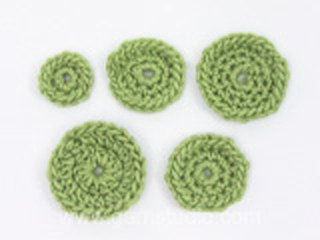

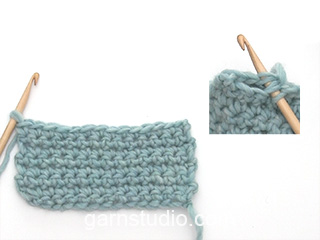

























Comments / Questions (53)
Est ce que je peux avoir le patron requin et sirène en francais merci et bonne journée
21.05.2021 - 14:42DROPS Design answered:
Bonjour Mme Levesque, tous nos modèles sont disponibles en français, cliquez sur le menu déroulant sous la photo pour changer la langue. Bon crochet et/ou tricot!
21.05.2021 - 14:55Hallo, eure Seite ist großartig! Ich würde gerne den Hai häkeln. Welches Garn könnte ich nehmen, das aus Kunstfaser ist? Der Hai soll ein Geschenk für eine vegane lebende Familie werden. Danke! Liebe Grüße, Ely
10.03.2021 - 09:54DROPS Design answered:
Liebe Ely, am besten benutzen Sie unseren Garnumrechner - mehr über Garnalternativen lesen Sie auch hier - Ihr DROPS Laden wird Ihnen auch mal gerne helfen, das passende Garn zu finden (auch telefonisch oder per E-Mail). Viel spaß beim stricken!
10.03.2021 - 13:47Je cherche une video pour faire une queue de sirene
26.01.2021 - 13:44DROPS Design answered:
Bonjour Marie-France, nous n'avons pas de vidéo pour ce modèle, suivez bien les explications pas à pas, si vous avez une question, vous pouvez la poser ici. Pensez également à consulter nos vidéos et leçons si besoin. Bon crochet!
26.01.2021 - 14:48Er det mulig å hekle rundt de første 20-30 cm av kroppen, så begynne å hekle frem og tilbake? Så jeg slipper å sy sammen tilslutt. Og stemmer det at luftmaskene skal hekles sammen til en sirkel, så hekles det frem og tilbake videre?
23.12.2020 - 13:03DROPS Design answered:
Hei Ingrid. Ja, det er mulig, og ja, luftmaskene hekles sammen til en sirkel for deretter å hekles frem og tilbake. mvh DROPS design
11.01.2021 - 14:33Hei, Jeg hekler hai-teppe i str. 11/12 år - benytter Eskimo fnr. 24 gul og heklepinne nr. 8. Heklefastheten stemmer med oppskriftens i bredden, men er litt kortere i høyden. Etter å ha brukt 550 g, måler teppet ca. 80 cm. Etter min beregning må jeg da bestille 450 g i tillegg for at teppet skal måle 124 cm. Er garnmengden feil? I så fall gikk jeg glipp av muligheten til å bestille Drops Deal fra kr. 18,- på garnet og få fri porto på hele bestillingen.
08.09.2020 - 19:30DROPS Design answered:
Hej Jorunn, Tak for info, vi har opdateret garnforbruget. Men garnforbruget er helt afhængig af strikkefastheden, du vil bruge en del mere garn hvis du har for mange pinde på 10 cm... God fornøjelse!
09.09.2020 - 14:33Hallo, meine Frage bezieht sich auf den Hai, wenn ich das richtig verstanden habe schließe ich die Luftmaschen mit einer Kettmasche. Soweit so gut,dann wird in hin und rückreihen weiter gemacht. Meine Frage nun ist wird trotzdem in der runde gearbeitet? LG Gabriele
05.08.2020 - 11:11DROPS Design answered:
Liebe Frau Thesing, die Arbeit wird dann in Hin- und Rückreihen gehäkelt, und am Ende mit einer Naht geschloßen - siehe SCHLITZ. Viel Spaß beim häkeln!
05.08.2020 - 16:27Vielen Dank für die tolle Anleitung! Ich habe gerade den Hai beendet. Das Ergebnis ist toll! Ich hatte mich schon über die unterschiedlichen Kommentare gewundert (die einen hatten Wolle übrig, die anderen deutlich zu wenig) und glaube, dass hier bei der Korrektur der Mengenangabe ein Fehler passiert ist. Kann das sein? Auch ich musste nachbestellen. Für Größe 134/140 habe ich 8 Knäuel in Mittelfranken mehr für den Körper benötigt. Also statt 450 gr waren es 850 gr!
27.07.2020 - 18:12DROPS Design answered:
Liebe Jennifer, vielen Dank für diesen Hinweis, das wird geprüft und ggf. angepasst. Schön, dass Ihr Hai so toll geworden ist - offenbar ein richtig haimeliger Mitbewohner! ;-)
28.07.2020 - 11:43Bei den Augen fehlt eine Runde in natur, oder? Ich denke, Runde 3 muss noch in natur gehäkelt werden und dann noch eine Runde feste Maschen in mittelgrau? Zumindest lässt das Bild mich das vermuten.
24.07.2020 - 13:54DROPS Design answered:
Liebe Jennifer, ja Sie haben Recht, auf dem Bild sieht es so aus, als ob eine Runde mit natur fehlt. Das Design-Team wird sich um die Korrektur kümmern, allerdings kann das aufgrund der Urlaubszeit etwas länger als sonst dauern. Der Vorschlag, den Sie gemacht haben, sollte passen - die 3. Runde mit natur und dann noch eine 4. Runde mit mittelgrau, in der 1 feste Masche in jede Masche gehäkelt wird. Viel Spaß "im Bauch" dieses gemütlichen Hais! :-)
25.07.2020 - 10:06Hei! Jeg har nettopp heklet Shark Attack Blanket i str 9/10år. I oppskrifen står det at man skal bruke 450 gr av den mellom-grå fargen. Jeg har brukt dobbelt så mye,dvs 900 gr, og da måler denne delen av teppet 103 cm. Jeg har selvfølgelig sjekket heklefastheten min, og den stemmer eksakt med oppgitte tall. Jeg kan ikke skjønne at det skal gå an å få heklet 108 cm med bare 450 gr som oppskriften sier. Dette til orientering . Vennlig hilsen Ranveig Nordstrand
19.07.2020 - 17:28Hej igen, det stämmer, jag har kollat virkfastheten och det är rätt enligt mönster. Jag har köpt all mängd garn för hela mönstret för att göra en i stl 13/14 år, alltså totalt 1200 gram. Det jag insåg att jag missade att skriva i min första fråga var att det gäller garnmängd Mellangrå, färg 46. Det är denna färg som kroppen ska vara i och 650 gram tycks inte räcka.
28.05.2020 - 10:05